🧊 Introduction – What You Need to Know Before Setting Up a Smart Fridge
In today’s hyper-connected world, your refrigerator isn’t just for keeping food cold anymore.
It’s an intelligent hub packed with Wi-Fi, touchscreen panels, voice control, and artificial intelligence designed to elevate your kitchen experience.
From managing grocery lists and checking what’s inside remotely to syncing with your smart home system and optimizing energy use—smart refrigerators are redefining convenience and efficiency.
But here’s the kicker: while these high-tech appliances are loaded with brilliant features, they’re only useful if set up properly.
That’s why knowing exactly how to set up a smart fridge is so important—and it’s not just about plugging it in.
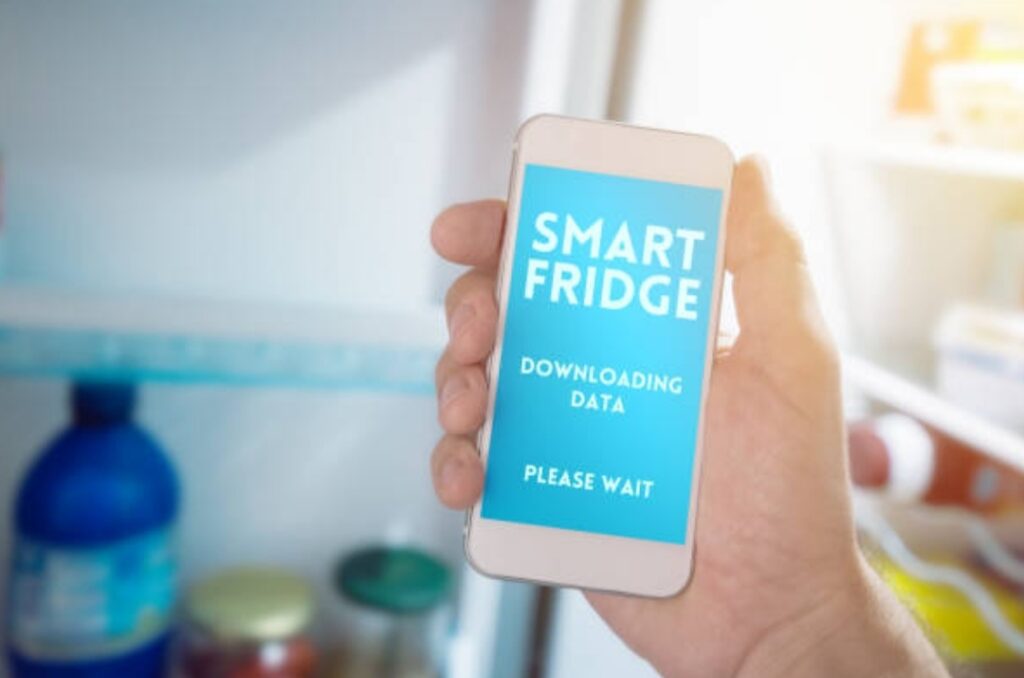
Smart fridges require careful configuration of wireless settings, companion apps, user profiles, and optional integrations with platforms like Amazon Alexa, Google Assistant, or Samsung SmartThings.
Many people buy a smart fridge expecting it to “just work.”
And when it doesn’t, they miss out on some of the most powerful features—like internal cameras that track expiration dates, energy usage analytics, or custom cooling modes for various ingredients.
This comprehensive guide will walk you through every step on how to set up a smart fridge the right way—from unboxing and connecting to Wi-Fi, to linking with voice assistants and securing your data.
And yes, we’ll make sure you don’t just connect it—you’ll master it.
Whether you own a Samsung Family Hub, LG InstaView ThinQ, Whirlpool Connected Appliance, or any other smart refrigerator brand, this article is your step-by-step manual.
It’s updated for 2025 and designed to work with the latest models and smart home technologies.
Even if you’re not tech-savvy, don’t worry.
We’ll break everything down in plain, friendly language—without the jargon—so you can feel confident setting up and using your fridge like a pro.
So if you’ve just brought home your smart fridge, or you’re planning to upgrade soon, bookmark this page right now.
You’re going to get expert tips, clear walkthroughs, and troubleshooting insights to make your experience smoother from Day One.
And if you’re comparing models or wondering how to connect a smart fridge to Wi-Fi, install its mobile app, or set up a family dashboard—we’ve got all that covered too.
From installation to automation, this is your ultimate smart refrigerator setup guide.
⚡ Let’s get your smart fridge up and running—and unlock the full potential of what it can do for your home, your meals, and your lifestyle.
💡 Pro Tip: For the best results, follow this guide from start to finish and keep your smart fridge’s user manual close at hand.
Also, look out for recommended smart fridge accessories that can improve functionality and efficiency.
🔥 Don’t miss a step—bookmark this post or print it out so you’re never left guessing during the setup process.
📌 Ready to make your kitchen smarter, cleaner, and more efficient?
Then keep reading, because what’s coming next could change the way you use your fridge forever.
What Is a Smart Fridge?
If you’ve recently heard terms like “AI fridge,” “Wi-Fi-enabled refrigerator,” or “intelligent appliance,” you’re not alone.
Smart fridges have surged in popularity as part of the growing smart home revolution.
But what exactly is a smart fridge—and why is it changing how we think about refrigeration?
A smart fridge, also known as a smart refrigerator, is a next-generation kitchen appliance that uses built-in connectivity and advanced software to perform a wide range of automated and interactive tasks.
These devices are designed to go beyond basic cooling—they can help you track food freshness, suggest recipes, reduce energy costs, and even talk to your smart assistant.
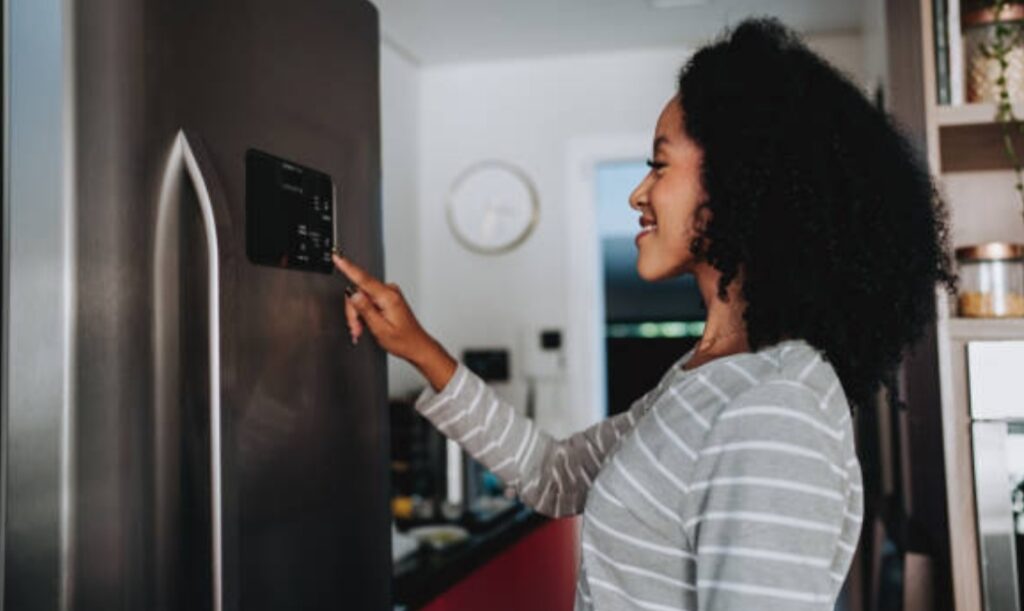
At the heart of it, a smart refrigerator combines traditional cold storage with smart technology, allowing you to interact with your appliance through apps, voice commands, and even touchscreens.
Whether you’re looking to save time, manage your diet, or simply enjoy modern convenience, smart fridges are engineered to bring high-tech functionality into everyday kitchen routines.
Let’s explore the groundbreaking features that set smart refrigerators apart.
Key Features and Capabilities
Wi-Fi Connectivity
One of the core features of any smart fridge is its ability to connect to the internet.
Through built-in Wi-Fi, your refrigerator can link to a mobile app or your smart home hub, allowing you to monitor and control it remotely.
Whether you’re adjusting the temperature from your phone or getting alerts when the door is left open, Wi-Fi connectivity brings convenience to your fingertips.
For example, Samsung’s Family Hub refrigerators use SmartThings to provide real-time updates and alerts via your smartphone.
This feature is essential when learning how to set up a smart fridge properly, as it’s the foundation for most other intelligent functions.
Touchscreen Interfaces
Many smart fridges now feature large LED or LCD touch panels on the front door.
These interactive screens can display everything from calendars and notes to weather forecasts and music streaming apps.
Samsung’s Family Hub, for example, lets you mirror your phone screen, play YouTube videos, and even leave digital post-it notes for the family.
This interface acts as the command center of your fridge—and often your entire kitchen.
Internal Cameras
Ever wonder what’s in your fridge while you’re at the grocery store?
With built-in internal cameras, smart fridges let you check the contents of your fridge remotely using a smartphone app.
These cameras can also be programmed to detect expiration dates or food inventory levels, helping reduce waste and eliminate unnecessary purchases.
LG’s InstaView and Samsung’s internal camera systems are excellent examples of this feature in action.
Voice Assistant Integration
Today’s smart refrigerators often come with native support for voice assistants like Amazon Alexa, Google Assistant, or Samsung Bixby.
This means you can ask your fridge questions like “What’s the temperature in the freezer?” or give it commands like “Add milk to my shopping list.”
This hands-free control is a game-changer, especially when your hands are full during meal prep.
Inventory Tracking
Many smart refrigerators come with software that helps track what items you have, what’s about to expire, and even what you need to buy.
Paired with barcode scanners or AI-assisted cameras, this inventory management system can sync with grocery delivery services or send you push notifications when you’re running low on essentials.
This is particularly useful for people trying to eat healthier, manage budgets, or reduce food waste.
Energy Monitoring
Another underrated but powerful feature is the ability to monitor and optimize energy usage.
Smart fridges provide reports on your electricity consumption and can activate power-saving modes during peak hours.
Some models even recommend settings based on your usage habits.
This feature not only helps the environment but can also reduce your utility bills over time.
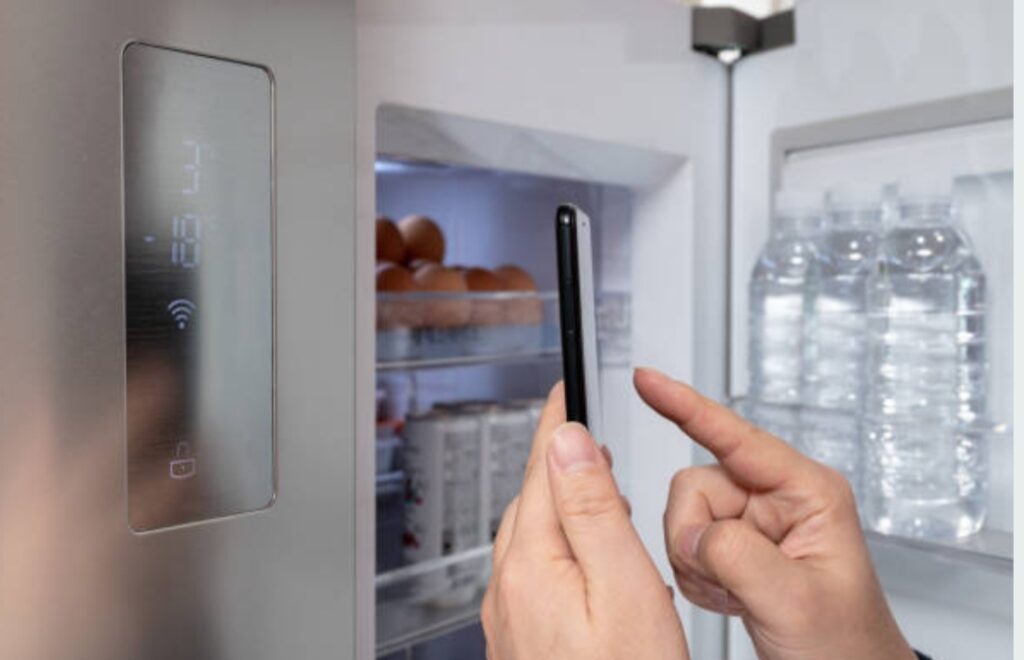
Benefits of Smart Refrigerators
Now that you understand the technology, let’s dive into the tangible, everyday benefits of owning a smart fridge.
Convenience and Remote Control
Imagine adjusting your fridge’s temperature while lying in bed.
Or getting a phone alert when your child leaves the door open.
Remote control capabilities mean you’re always in charge, no matter where you are.
Smart fridges allow you to start quick freeze cycles, activate power-saving modes, and even order groceries straight from the touchscreen.
Energy Efficiency
Smart refrigerators often use adaptive cooling technologies that adjust based on how frequently you open the door or how full the fridge is.
They learn your habits and apply energy-saving strategies automatically.
Plus, energy usage reports help you track and reduce your household electricity consumption.
This makes them ideal for eco-conscious users and budget-savvy families alike.
Food Management & Waste Reduction
Tired of throwing away spoiled groceries?
With internal cameras, expiration reminders, and inventory tracking, smart fridges help you stay on top of what you have and what needs to be used soon.
Many models can even suggest recipes based on what’s already in your fridge.
This makes meal planning faster, smarter, and more cost-effective.
Integration with Smart Home Ecosystems
If you already use smart home devices like Amazon Echo, Google Nest, or smart lighting systems, your smart fridge can integrate seamlessly.
You can sync it with routines, like dimming the kitchen lights and lowering the temperature when you say “Goodnight.”
Or have it display your family’s schedule on the touchscreen every morning.
The possibilities are endless when your fridge becomes part of a unified smart home strategy.
🔥 Ready to unlock all these features and benefits?
Then make sure you follow this guide carefully to set up your smart fridge the right way—so you’re not leaving any innovation behind.
Pre-Installation Checklist
Before you even unbox your brand-new smart refrigerator, it’s essential to prepare your space properly.
Failing to plan can lead to serious issues—like poor air circulation, door clearance problems, or even voided warranties.
This section will walk you through everything you need to check before installation.
From measuring your kitchen to ensuring a reliable Wi-Fi signal, these steps will help you understand how to set up a smart fridge correctly and efficiently.
Following this pre-installation checklist ensures that your appliance operates at peak performance and integrates seamlessly with your smart home system.
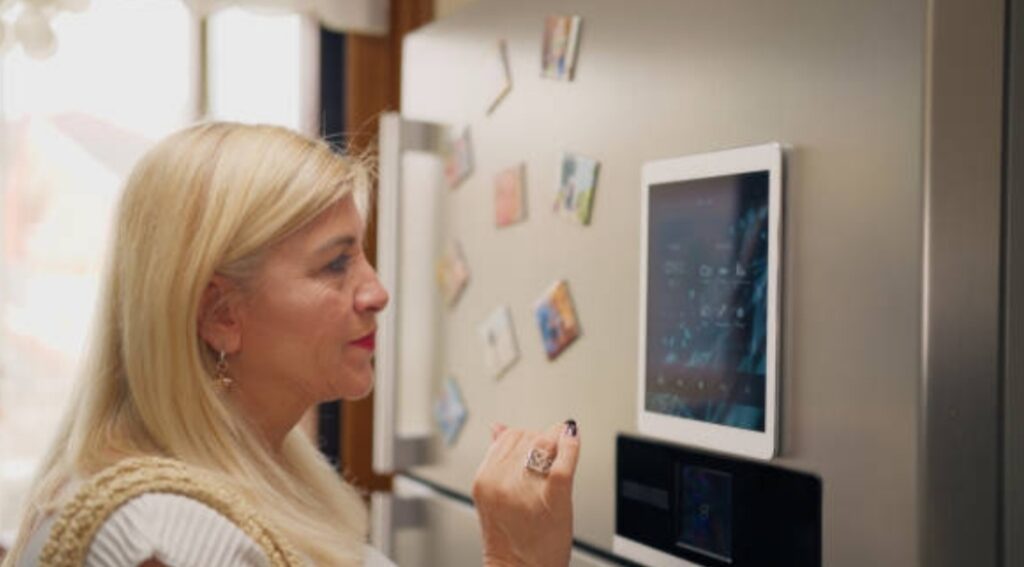
Measuring Your Space
Accurate measurements are crucial.
Smart fridges are larger and more feature-rich than traditional models, so you must make sure they fit your space with proper clearance on all sides.
Doing this prevents overheating, door misalignment, and long-term performance issues.
Ensure Adequate Clearance
Your smart fridge needs space to breathe—literally.
Lack of airflow can cause the compressor to overheat or reduce energy efficiency.
Follow these minimum clearance guidelines:
- Leave at least 1 inch (2.5 cm) of space behind the fridge for airflow.
- Leave at least ⅜ inch (about 1 cm) on both sides and above the unit.
- Allow for 2.5 inches (6.4 cm) of space on the hinge side if your fridge is placed against a wall—this prevents the door from hitting the wall when opened.
Double-check your kitchen cabinets and layout for obstructions.
Many users forget to factor in crown molding or overhead cabinets when measuring height.
Verify Door Swing Clearance
Smart fridges often come with French doors or pull-out freezer drawers.
Open and close the doors fully to ensure nothing blocks them.
Will the fridge door hit a kitchen island?
Can you pull out the bottom freezer bin without interference?
These are small but critical details that impact day-to-day convenience.
We recommend using painter’s tape to map out the footprint and door swing before finalizing placement.
This helps visualize how the unit will move within your kitchen space.
Preparing the Installation Area
Now that your measurements are set, it’s time to prepare the installation zone.
Smart refrigerators rely on more than just space—they also need stable support, power access, and a strong Wi-Fi signal.
Level, Hard Flooring
Smart fridges need a stable, level surface to function properly.
Avoid placing them on carpet or uneven tile.
Uneven flooring can cause vibration, door misalignment, or sensor malfunction over time.
Use a carpenter’s level to test the surface.
If necessary, use plywood or leveling mats to stabilize the appliance.
Proximity to Power Outlet and Water Line (If Applicable)
Your installation area should be near a dedicated grounded electrical outlet—preferably within 3 feet of the fridge.
Avoid using extension cords or power strips, as they can interfere with voltage and smart functions.
If your model includes a water dispenser or ice maker, make sure the water line hookup is nearby.
Most manufacturers recommend using copper or braided stainless steel tubing for reliability and long-term performance.
Stable Wi-Fi Signal Strength
This is one of the most overlooked but essential parts of setting up a smart fridge.
Most smart refrigerator functions—like remote control, firmware updates, inventory alerts, and smart home syncing—rely on a steady Wi-Fi connection.
Here’s how to check your signal:
- Use your smartphone or tablet to test Wi-Fi strength near the fridge location.
- Look for at least 2 bars of signal.
- If needed, consider adding a Wi-Fi extender or mesh router to eliminate weak zones.
💡 Pro Tip: Avoid placing the fridge in enclosed areas like tight pantries or against thick concrete walls—these can block Wi-Fi signals and reduce connectivity.
⚠️ Don’t skip this checklist.
Even the most advanced fridge will fail to perform well if the environment isn’t properly prepped.
🛠️ Get your space fridge-ready with the right clearances, a stable floor, accessible power, and solid Wi-Fi—your smart kitchen deserves it.
Unboxing and Physical Setup
Setting up your smart fridge begins long before you plug it in.
Unboxing and positioning it correctly is a critical step to ensure its long-term performance, safety, and efficiency.
In this section, we’ll walk you through every detail of the physical setup—from the moment it arrives at your doorstep to the first drop of filtered water.
Properly understanding how to set up a smart fridge physically ensures that it works flawlessly with all smart features, sensors, and integrations from Day One.
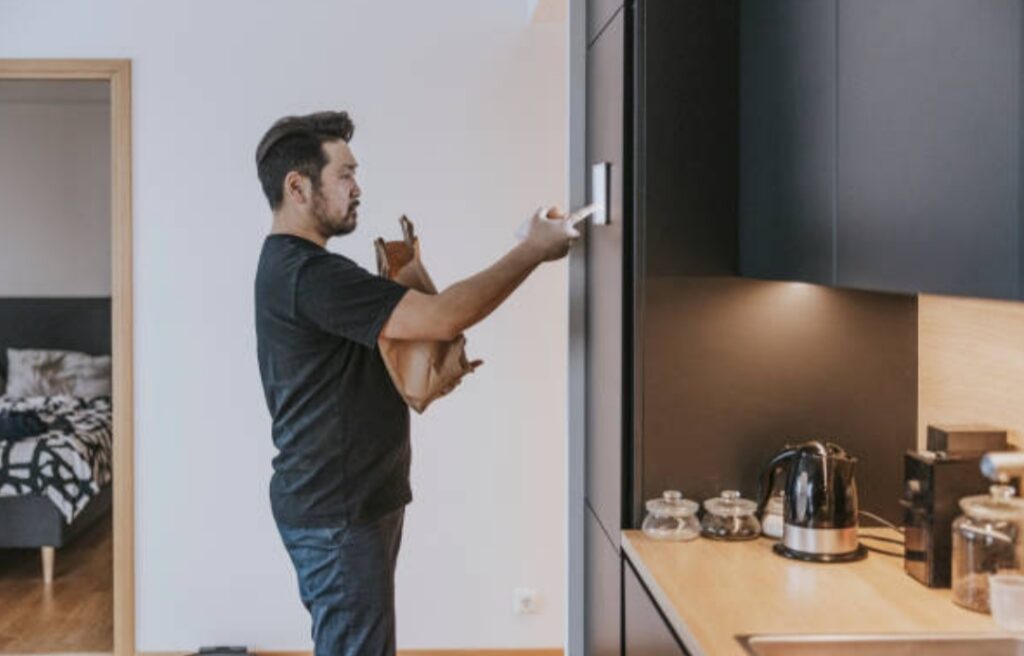
Unpacking Safely
Before you get excited to plug in your smart appliance, you must unpack it carefully to avoid damage or injury.
Inspect for Shipping Damage
Begin by inspecting the exterior of the packaging for any signs of damage such as dents, holes, or punctures.
If you notice damage upon delivery, take photos and notify the retailer or shipping provider immediately.
Do not sign off on delivery until you’ve verified that the unit is intact.
This step is especially important for premium models like Samsung Family Hub or LG InstaView ThinQ, which can contain delicate tech components.
Remove Protective Materials
Use scissors or a utility knife to open the box—avoid cutting too deep as you could damage the appliance’s finish.
Remove any protective tape, plastic film, foam inserts, and cardboard spacers from both the inside and outside.
Don’t forget to peel off internal stickers or QR codes that could block sensors or air vents.
Removing these materials thoroughly will prevent overheating or sensor interference once the fridge is operational.
Check for Included Accessories
Open all interior compartments, freezer drawers, and side bins to locate accessories and instruction manuals.
Your box may include:
- Water line connectors
- Ice bin
- Shelves
- User manual and warranty card
- Touchscreen stylus (if applicable)
Keep these items together in a safe spot for installation and setup.
Positioning the Fridge
Once your smart fridge is unpacked, it’s time to move it into its final location.
Move into Place Carefully
Use a furniture dolly or call for help to move the fridge upright and gently into your desired kitchen corner or nook.
Avoid tilting the fridge more than 45° to prevent damaging the compressor.
If your smart refrigerator has rear wheels or adjustable legs, use them to guide it slowly into position.
Level the Appliance Using Adjustable Feet
Ensuring your fridge is level is crucial.
An unbalanced smart fridge can cause the doors to swing open, leak water, or interfere with the internal cameras and sensors.
Place a level on the top or bottom interior shelf to check for stability.
Use a wrench to adjust the front leveling feet until the unit is completely balanced.
If you’re unsure, consult the manual or search the brand’s official website for support.
Attach Door Handles If Not Pre-Installed
Some smart fridges ship with handles detached for safer transport.
Locate the handle mounting screws (usually found inside the unit) and carefully align the handles before securing them.
Tighten the screws using a screwdriver but be careful not to overtighten and damage the threading.
Samsung and LG models often use a click-lock mechanism—refer to their specific instructions for best results.

Connecting Water Line (If Applicable)
If your smart fridge includes an automatic ice maker or water dispenser, it will require a connection to a cold water source.
Follow Manufacturer Instructions
Locate the inlet valve on the back of your fridge, usually labeled “Water In.”
Use the water line connector included in the packaging (or purchase a universal fridge water line kit) to link it to your kitchen’s water supply.
Tighten the nut until snug, but do not overtighten.
If needed, use Teflon tape to seal the threads.
Be sure to follow all brand-specific steps in your user manual, especially for high-end smart models.
Flush the System by Dispensing a Gallon of Water
Once connected, turn on the water supply and dispense at least 1 gallon of water through the dispenser.
This clears out any air bubbles, plastic residue, or potential contaminants from the tubing.
Discard this water—it’s not yet safe to drink.
Repeat this step until the water runs clean and clear.
Discard the First Two Batches of Ice
Smart fridges may automatically begin making ice after water is connected.
However, you should discard the first two full batches of ice, as they may contain residue or microplastics from internal components.
Once clean, the ice maker is ready for daily use.
Many models will notify you through the app or touchscreen when the system is fully operational.
💥 Don’t skip these crucial setup steps.
Taking 15–30 minutes to unbox, level, and connect your smart fridge properly will ensure years of seamless performance and smart integration.
👉 Next: Let’s walk through connecting your smart fridge to Wi-Fi and mobile apps for full control—from anywhere in the world.
🛠️ Optional Tools and Accessories You May Need:
- Smart Fridge Water Line Installation Kit
- Adjustable Wrench
- Furniture Dolly for Appliance Moving
- Surge Protector for Smart Refrigerators
Connecting to Wi-Fi and Smart Apps
Smart refrigerators offer incredible features—but only when they’re connected properly to Wi-Fi and a dedicated app.
Whether you’re interested in remote monitoring, food expiration alerts, or energy optimization, this section is critical for anyone learning how to set up a smart fridge.
We’ll walk you through enabling Wi-Fi on your appliance, installing the right manufacturer apps, and fixing any connectivity issues.
By the end, your fridge will be fully online and smart-home ready.
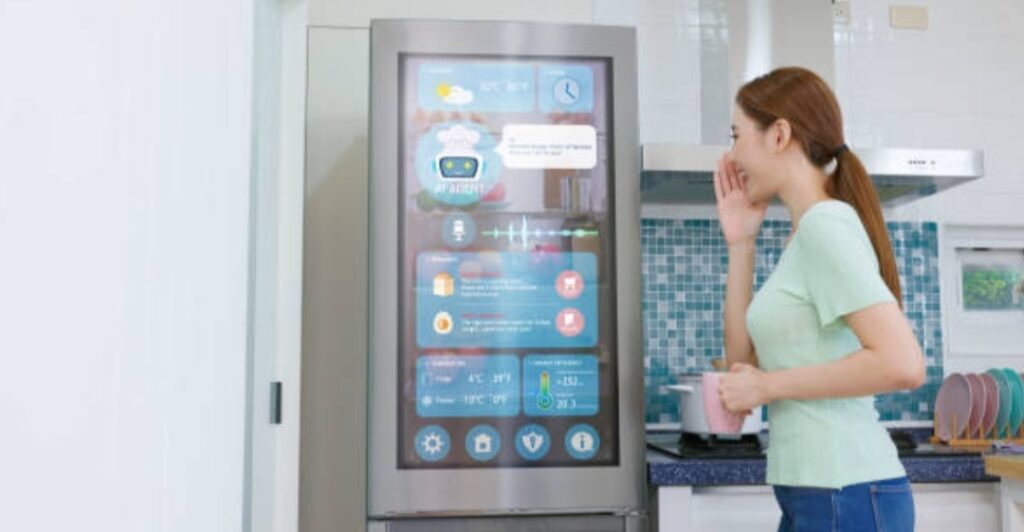
Enabling Wi-Fi on the Fridge
The very first step to unlocking your smart refrigerator’s capabilities is activating its Wi-Fi connection.
Here’s how to do it—step by step:
Access Control Panel Settings
Locate the main control panel on your smart fridge.
On most models, it’s either on the front touchscreen or just inside the door.
Tap or press the “Settings” or “Wi-Fi” icon.
This will open the connectivity menu.
Select Wi-Fi Setup Mode
Look for a button labeled “Wi-Fi Setup,” “Network,” or “Smart Connect.”
Once selected, your fridge will begin scanning for nearby wireless networks.
Wait a few moments for the list to populate.
Choose Your Home Network and Enter the Password
Select your home Wi-Fi network (preferably the 2.4 GHz band unless the model supports 5 GHz).
Enter your password using the on-screen keypad or directional arrows.
Confirm the connection.
You should see a success message or a signal icon indicating the fridge is online.
💡 Pro Tip: Always double-check your caps lock and ensure the Wi-Fi password is typed correctly. Typos are one of the most common setup errors.
Installing and Configuring Manufacturer Apps
To take full advantage of your smart fridge’s functionality, you’ll need to install its companion mobile app.
Each brand offers its own app packed with remote controls, diagnostics, and customization tools.
Samsung SmartThings
Samsung’s SmartThings app is a hub for all your connected devices—including your smart fridge.
Here’s how to get started:
- Download the SmartThings app from Google Play or Apple App Store.
- Sign in with your Samsung account or create one if you’re new.
- Tap the “+” icon to add a new device.
- Choose “Refrigerator” and follow on-screen pairing instructions.
- Assign your fridge to a specific room (e.g., Kitchen).
- Explore features like temperature adjustment, energy usage, and alerts for open doors.
LG ThinQ
The LG ThinQ app transforms your refrigerator into a smart powerhouse.
To get started:
- Download LG ThinQ from Google Play or Apple App Store.
- Log in or create an LG account.
- Tap “Add Device,” choose “Refrigerator,” and follow pairing steps.
- Enable notifications for low ice, filter replacements, or energy-saving modes.
- Control temperature settings, diagnostics, and more—remotely.
Panasonic SmartApp+
Panasonic users can enjoy unique features through the SmartApp+ platform.
Here’s how:
- Download Panasonic SmartApp+ on your phone.
- Use Bluetooth or Wi-Fi to detect and connect to your refrigerator.
- Enable push notifications for open-door warnings or Prime Freeze completions.
- Customize Prime Freeze and Quick Cool modes right from your device.
📲 Bonus: Most smart fridge apps let you check grocery inventory, get recipe recommendations, or sync with Alexa and Google Assistant.
Look in the settings or integrations tab for these extras!
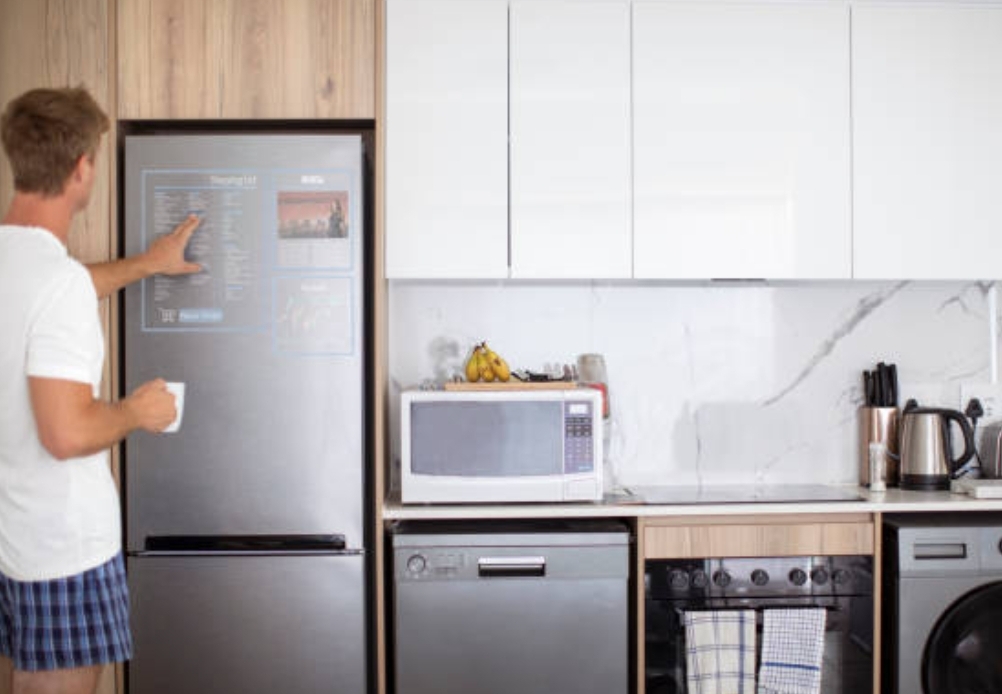
Troubleshooting Connectivity Issues
Not everything goes smoothly 100% of the time.
If you’re having trouble connecting your smart fridge to Wi-Fi or syncing it with the app, here are some common fixes:
Ensure the Fridge is Within Wi-Fi Range
If the fridge is far from your router, the signal may be too weak.
Use a phone to check signal strength near the appliance.
If you only get 1 bar, consider installing a Wi-Fi extender.
Restart the Router and Appliance
Unplug the refrigerator for 30 seconds, then plug it back in.
Also reboot your router to clear any temporary connection glitches.
Check for Firmware Updates
Navigate to the “Settings” panel on your fridge’s touchscreen or app.
Look for “Software Update” or “Firmware Update.”
Apply any available updates—they often resolve Wi-Fi and app pairing bugs.
📞 Still stuck? Contact the brand’s customer support or check their FAQ page for troubleshooting help.
Many companies offer live chat or callback services for fast resolution.
⚠️ Don’t miss out on your fridge’s smartest features.
📲 Get connected, stay updated, and explore advanced features here.
Maintenance and Best Practices
Maintaining your smart fridge is essential for ensuring its longevity, efficiency, and security.
Smart appliances, just like traditional ones, require regular upkeep to perform at their best.
By staying on top of updates, cleaning, and securing your device, you can enhance its functionality and extend its lifespan.
Here are some best practices and maintenance tips to keep your smart fridge running smoothly and securely.
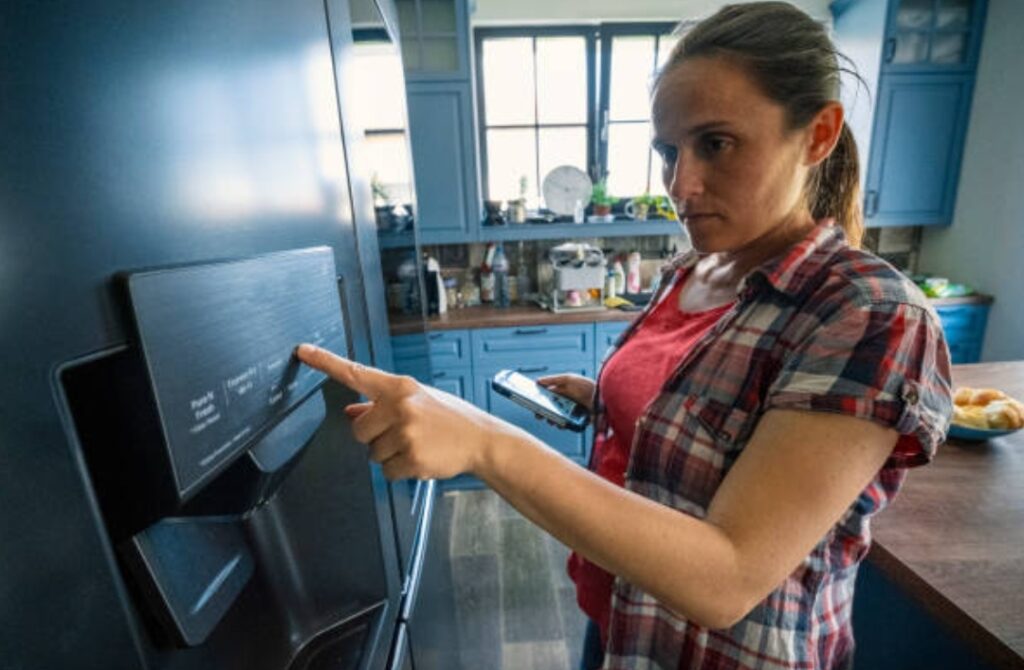
Keeping Firmware and Software Updated
Firmware and software updates are crucial for keeping your smart fridge at the cutting edge of performance and security.
These updates ensure that your device remains compatible with new features and security standards, preventing any issues that might arise from outdated software.
Here’s how you can maintain your fridge’s software effectively:
- Enable Automatic Updates When Available
Most modern smart fridges offer an option to enable automatic updates.
This ensures that your appliance receives the latest patches and improvements without requiring manual intervention.
Enabling this feature guarantees your device stays current and secure.
- Regularly Check App and Device for New Features
Even if automatic updates are enabled, it’s still a good idea to occasionally check your appliance’s app or the fridge’s control panel for new features.
Manufacturers often roll out enhancements and tools that could enhance your experience with the appliance.
Keeping up with these updates will ensure you are getting the most out of your device.
- Benefits of Updated Firmware: Security, Performance, and Compatibility
Updated firmware doesn’t just improve your fridge’s functionality—it also keeps it secure from potential vulnerabilities.
Updates can address security flaws and ensure that your fridge can interact properly with other smart home devices.
Furthermore, regular updates can prevent performance issues and increase the lifespan of your fridge.
Pro Tip: Set a reminder every few months to manually check for updates, even if auto-updates are enabled. Some manufacturers may not push updates automatically but will notify you via app notifications.
Cleaning and Care Tips for Smart Components
A smart fridge comes with several sensitive components, including touchscreens, cameras, and sensors.
These require careful attention to ensure they continue to function correctly.
Here are some essential tips to help you maintain your smart fridge’s components:
- Clean Touchscreen Displays and Control Panels with a Microfiber Cloth
Touchscreens are a major part of many modern smart fridges.
Over time, fingerprints, dust, and grime can accumulate on the display. Use a soft microfiber cloth to gently clean these surfaces.
Avoid using harsh chemicals that could damage the screen.
Tip: For better results, dampen the microfiber cloth with a little water and gently wipe down the surface.
- Avoid Spraying Liquids Directly onto Smart Sensors or Panels
While cleaning the exterior, avoid spraying any cleaning solution directly onto the fridge’s sensors, control panels, or smart cameras.
Spraying liquids directly can cause electrical issues and damage internal components. Instead, lightly dampen the cloth and wipe gently.
- Inspect Water Filters and Replace as Per Manufacturer’s Recommendations
Many smart fridges have water and air filters that need regular inspection and replacement.
Over time, these filters can become clogged with debris, affecting water quality and the fridge’s performance.
Most manufacturers provide guidelines on how often to replace the filters, typically every 6 to 12 months, depending on usage.
Tip: Keep a schedule or use a reminder app to stay on top of this task
Pro Tip: For deep cleaning, consider using a vacuum with a brush attachment to clean the refrigerator’s coils and vents. This can prevent overheating and improve the appliance’s energy efficiency.

Data Privacy and Security
Smart fridges are part of your connected home ecosystem, meaning they collect and share data.
From monitoring food inventory to analyzing energy usage, these devices are continuously transmitting information.
It’s crucial to protect your privacy and data security while using your appliance.
Here are some tips to ensure your fridge’s data and your personal information remain secure:
- Secure Your Wi-Fi with WPA2 Encryption
Your fridge connects to your home Wi-Fi network, so it’s important to secure your Wi-Fi with WPA2 or WPA3 encryption.
This ensures that your connection is encrypted and prevents unauthorized users from accessing your network.
Tip: If you haven’t already, consider updating your router to a model that supports the latest encryption standards to ensure maximum security.
- Use Strong, Unique Passwords for App Accounts
The apps connected to your smart fridge allow you to monitor and control the appliance remotely.
To protect your data, always use a strong, unique password for each account.
Avoid using the same password for multiple apps, and consider using a password manager to help store and generate strong passwords.
Tip: Enable two-factor authentication (2FA) for your fridge’s app if the manufacturer supports it. This adds an extra layer of security.
- Understand Data-Sharing Policies of the Manufacturer
Before using the app and cloud-based features, it’s important to understand what data the manufacturer collects and shares.
Many smart fridge manufacturers collect data on usage patterns, inventory tracking, and energy consumption.
Read the privacy policy to ensure you’re comfortable with how your data is being used.
Tip: Consider opting out of any data-sharing options that you don’t find essential to your experience.
Common Smart Fridge Setup Issues and How to Fix Them
While setting up a smart fridge is typically a straightforward process, there are a few common issues that may arise during installation or setup.
These issues can range from connectivity problems to unresponsive features.
Thankfully, many of these issues can be easily resolved with a few troubleshooting steps.
Below, we’ve compiled a list of the most common setup problems and how you can quickly fix them.
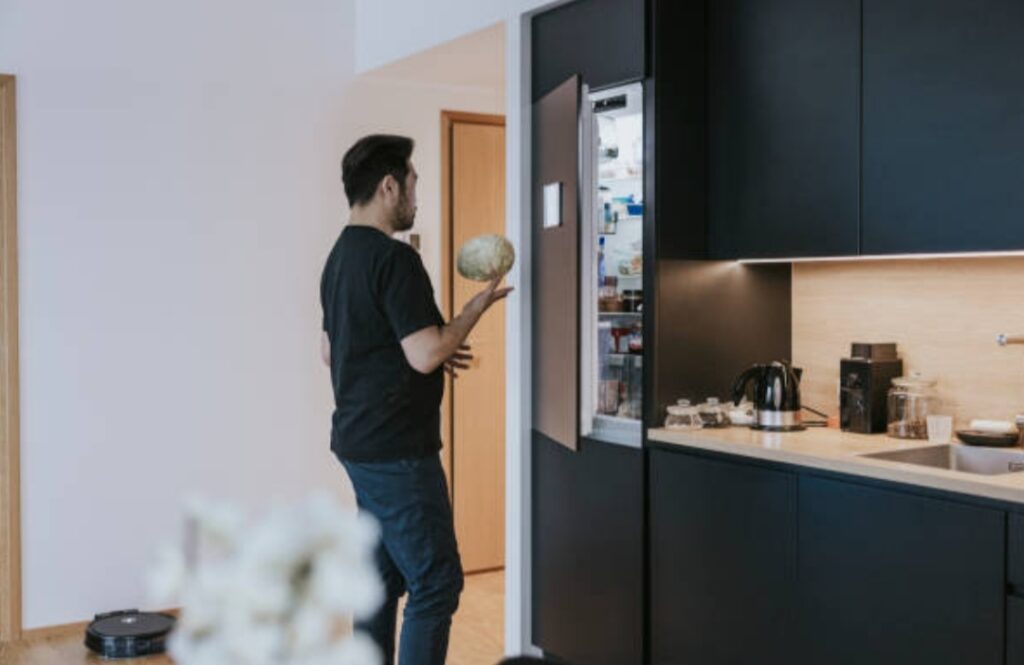
Smart Fridge Not Connecting to Wi-Fi
A smart fridge that isn’t connecting to your home Wi-Fi network can be frustrating, as many of the fridge’s advanced features, such as inventory tracking, remote control, and app notifications, rely on an internet connection.
Here’s how to troubleshoot this issue:
- Reset Network Settings
One of the simplest ways to fix Wi-Fi connectivity issues is to reset your fridge’s network settings.
This will erase any stored Wi-Fi networks and allow you to start fresh with a new connection.
To reset the network settings, follow the instructions in your fridge’s user manual or access the settings through the control panel.
- Confirm Router Compatibility (2.4GHz vs 5GHz)
Many smart fridges are designed to connect to 2.4GHz Wi-Fi networks, which offer a wider range but slower speeds.
If your router is broadcasting on 5GHz, your fridge may not be able to connect.
To fix this, ensure your router is configured to broadcast on the 2.4GHz band or switch to a dual-band router that supports both frequencies.
- Move Router Closer or Install a Wi-Fi Extender
If your fridge is located far from your router, it may be out of range of the Wi-Fi signal.
Try moving the router closer to the fridge or install a Wi-Fi extender to boost the signal in the kitchen.
A stronger signal will improve connectivity and help your fridge stay online.
App Not Recognizing the Fridge
The app that comes with your smart fridge is an essential part of its functionality, allowing you to control and monitor the appliance remotely.
If the app isn’t recognizing your fridge, try these steps:
- Reinstall the App
Sometimes, simply uninstalling and reinstalling the app can resolve recognition issues.
This ensures you have the latest version of the app and clears any app-related bugs that may be preventing the fridge from connecting.
After reinstalling, open the app and follow the instructions to add your fridge again.
- Check for Device Compatibility
Make sure that your phone or tablet is compatible with the app required to control the fridge.
Some apps may not be compatible with certain operating system versions, so check the app’s requirements on the app store.
Additionally, ensure that your device has Bluetooth or Wi-Fi enabled, depending on how your fridge connects to the app.
- Power Cycle Both Fridge and Phone
A power cycle can help resolve temporary connectivity issues between the fridge and your app.
Turn off both your fridge and your smartphone for about 10 seconds and then turn them back on.
After restarting both devices, attempt to reconnect them via the app.
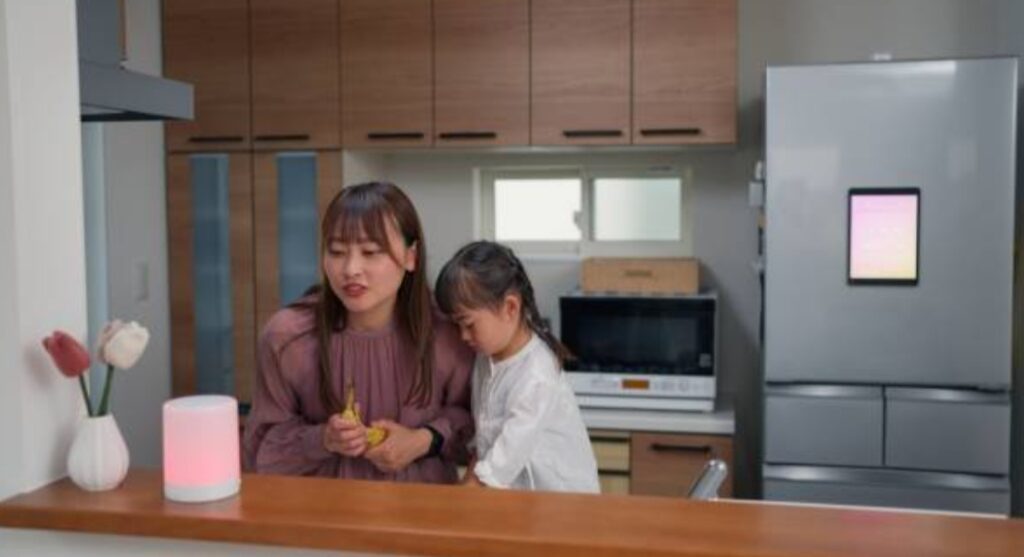
Features Not Responding or Lagging
If some of the smart features of your fridge are unresponsive or experiencing lag, this can disrupt your ability to control the appliance effectively.
Here’s how to fix these issues:
- Restart the Appliance
Just like with any electronic device, restarting your smart fridge can often resolve issues with unresponsive features.
Unplug the fridge for about 30 seconds, plug it back in, and power it on.
This resets the appliance and can help resolve any glitches causing the features to lag or freeze.
- Ensure the App Is Up to Date
An outdated app version may not communicate properly with your fridge.
Check the app store on your phone or tablet to see if there’s an available update.
Updating the app will ensure you have access to the latest bug fixes and new features.
After updating, try using the fridge’s features again.
- Perform a Factory Reset if Needed
If all else fails, you may need to perform a factory reset on the fridge.
This will restore the appliance to its default settings, erasing all custom configurations and preferences.
Follow the instructions in your user manual to perform a factory reset.
After resetting, you can set up the fridge again and check if the features are working properly.
Comparison: Smart Fridge Models & App Ecosystems
With the rise of smart home technology, the market for smart refrigerators has expanded, offering a range of models and ecosystems to choose from.
When selecting a smart fridge, it’s important to consider the app usability, feature availability, and compatibility with your existing smart home ecosystem.
In this section, we’ll compare some of the top brands—Samsung, LG, Whirlpool, and Panasonic—to help you make an informed decision based on your preferences and needs.

Samsung vs LG vs Whirlpool vs Panasonic
Each of these major appliance brands offers unique smart fridge models with distinct features and app ecosystems.
Let’s break down what each brand brings to the table.
App Usability
- Samsung SmartThings
Samsung’s SmartThings app is one of the most robust and widely used smart appliance apps.
It offers an intuitive interface that lets users control their fridge remotely, receive notifications, and even track inventory.
The app’s compatibility with other Samsung appliances and third-party smart devices (like thermostats, lights, and security cameras) makes it an excellent choice for those building a comprehensive smart home ecosystem.
- LG ThinQ
LG’s ThinQ app is also user-friendly, providing remote control, energy monitoring, and even the ability to receive alerts for maintenance or malfunction.
While it is feature-rich, some users report that it can be a bit slow when syncing with the fridge or other LG appliances.
However, it offers deep integration with Google Assistant and Amazon Alexa, which is a huge benefit for users looking for voice control.
- Whirlpool WFC App
Whirlpool’s app is straightforward and focuses on basic smart fridge functions such as temperature control, alerts, and energy monitoring.
It is not as feature-packed as Samsung’s or LG’s apps, but it works well for those who want a no-frills experience with easy setup and integration.
- Panasonic Smart App+
Panasonic’s Smart App+ offers basic controls and notifications for fridge users.
It connects to the fridge via Bluetooth or Wi-Fi, allowing you to customize settings such as Prime Freeze and receive door-open notifications.
While it does not have the extensive capabilities of Samsung or LG apps, it’s a good option for users who want essential functionality without the complexity of advanced smart features.
Feature Availability
- Samsung
Samsung’s smart fridges are packed with features, including internal cameras that let you see the contents of your fridge remotely, AI-powered food tracking, and smart voice assistant integration (Bixby, Alexa, and Google Assistant).
The SmartThings app offers deep customization options and integration with a wide range of smart devices, including Samsung’s line of smart home products.
- LG
LG’s models often feature energy-efficient technologies and food management tools, such as InstaView (a door-in-door feature that lets you see inside the fridge without opening it) and Smart Diagnosis (which helps troubleshoot issues via the app).
Their app also integrates with Google Assistant and Alexa for voice-controlled functions, making it a great option for users who value voice assistance.
- Whirlpool
Whirlpool’s smart fridges are designed with ease of use in mind, with features like temperature control, notifications for filter changes, and energy monitoring.
Some models even have a fingerprint-resistant finish, making maintenance easier.
However, they lack the advanced food tracking and internal camera features found in higher-end models from Samsung and LG.
- Panasonic
Panasonic’s smart fridges focus more on energy efficiency and providing basic smart functionalities like custom freezing settings and notifications.
They do not include advanced features like AI-powered food tracking or cameras, but their focus on high-quality cooling and smart app connectivity makes them a reliable choice for simple smart fridge needs.
Smart Home Ecosystem Compatibility
- Samsung
Samsung’s SmartThings app is highly compatible with a wide range of smart home devices, including lights, thermostats, cameras, and security systems.
If you have other Samsung smart products, the integration is seamless.
Furthermore, SmartThings is compatible with both Amazon Alexa and Google Assistant, enabling voice control over various appliances in your home.
- LG
LG ThinQ also integrates with both Amazon Alexa and Google Assistant.
However, it’s not as deeply integrated with third-party smart devices as Samsung’s ecosystem.
Still, it offers great voice control and is ideal for those looking to incorporate smart fridge functionality into a voice-activated home system.
- Whirlpool
Whirlpool’s ecosystem compatibility is more limited compared to Samsung and LG.
Whirlpool fridges work with the Whirlpool app and can integrate with Amazon Alexa and Google Assistant, but they do not have the same broad integration capabilities with other smart home systems.
This may be a consideration for users looking to build a more interconnected smart home.
- Panasonic
Panasonic smart fridges also support integration with Alexa and Google Assistant, but their ecosystem is not as expansive as Samsung or LG.
While their app connects well with the fridge, it lacks broader compatibility with third-party smart devices.
This may be a limitation for users looking for advanced smart home integration.

Pros and Cons of Different Smart Fridge Types
Choosing the right smart fridge not only depends on the brand and ecosystem but also on the specific type of fridge that best fits your lifestyle.
Below, we compare the pros and cons of various smart fridge designs and features.
French Door vs Side-by-Side vs Top Freezer
- French Door
Pros:
- Offers a large capacity, ideal for big families.
- Flexible interior layout with adjustable shelves.
- Modern aesthetic with a double-door fridge and a bottom freezer.
Cons:
- Can be more expensive than other designs.
- Requires more space to open the wide doors.
- Side-by-Side
Pros:
- Slimmer design, ideal for narrow kitchens.
- Offers quick access to both the fridge and freezer sections.
- Easier to organize with clear separation of fridge and freezer compartments.
Cons:
- Freezer space is usually smaller than in other designs.
- Limited shelf space in the fridge section.
- Top Freezer
Pros:
- Typically more affordable than other designs.
- Classic design that has stood the test of time.
Cons:
- Less convenient for accessing items in the fridge section, as the freezer is located at the top.
- Smaller overall capacity compared to French door models.
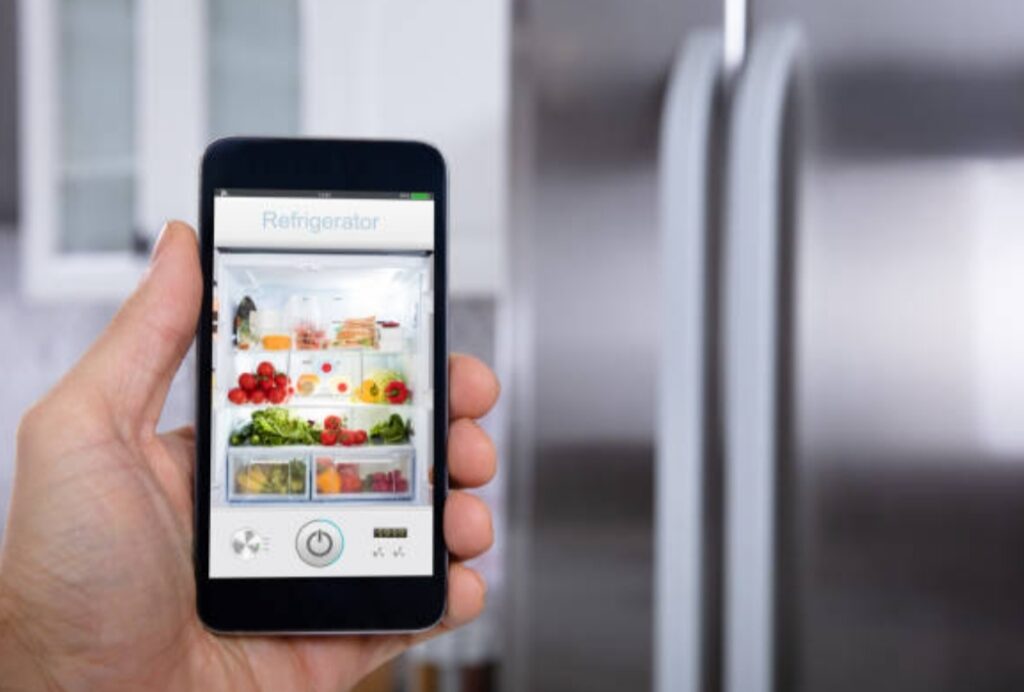
Camera and AI Features vs Basic Smart Functions
- Smart Fridges with Cameras and AI
Pros:
- Internal cameras let you check the contents of your fridge remotely.
- AI-driven features track food inventory, expiration dates, and suggest recipes.
- Advanced smart functions, such as voice assistant control, enhance convenience.
Cons:
- Typically more expensive.
- Requires a stable Wi-Fi connection for optimal performance.
- Basic Smart Fridges
Pros:
- More affordable and easy to use.
- Includes essential smart features, such as temperature control and energy monitoring.
Cons:
- Lack of advanced features like AI food tracking and internal cameras.
- May not integrate as deeply with other smart home devices.
How to Use Your Smart Fridge to Save Time and Money
Smart refrigerators are more than just a luxury; they can significantly enhance your kitchen experience while saving both time and money.
With advanced features like internal cameras, smart scheduling, and energy optimization, these appliances are designed to improve convenience and minimize waste.
In this section, we’ll explore some of the ways you can leverage the full potential of your smart fridge to streamline your daily routines and make smarter, more cost-effective choices.
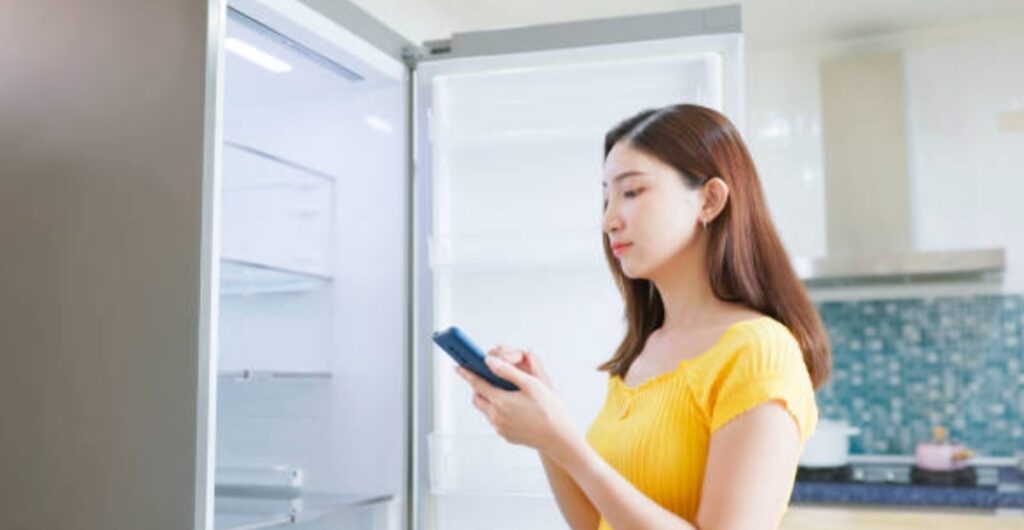
Automate Grocery Lists and Expiration Alerts
One of the most powerful ways to use your smart fridge to save time and money is by automating grocery lists and tracking food expiration dates.
With built-in smart technologies, such as internal cameras and inventory management tools, you can easily keep track of what’s inside your fridge, making shopping trips more efficient.
- Enable Internal Camera Tracking
Many modern smart fridges come with internal cameras that allow you to view the contents of your fridge remotely.
By simply using your smartphone, you can quickly check what you have at home and avoid purchasing items you don’t need.
This feature is especially useful when you’re at the store, as it ensures you don’t accidentally buy duplicates of items you already have.
- Integrate with Compatible Grocery Delivery Services
Some smart fridges, such as Samsung’s Family Hub, are compatible with grocery delivery services, allowing you to create a shopping list directly from the fridge’s touchscreen interface or via the app.
You can quickly order groceries without ever leaving your home. This is especially convenient for busy individuals and families, saving both time and effort.
- Set Expiration Alerts
Another way to avoid wasting food is by setting up expiration alerts.
Many smart fridges can notify you when perishable items are about to expire.
With this feature, you can plan meals ahead of time to use up ingredients before they spoil, reducing food waste and saving money on groceries.
Some apps even suggest recipes based on what you have left in your fridge to make the most of your current ingredients.
Use Smart Scheduling to Optimize Energy Usage
Smart fridges aren’t just about convenience—they can also help you save money by reducing energy consumption.
With smart scheduling features, you can optimize your fridge’s energy usage based on your lifestyle and habits.
- Set Vacation or Away Modes
If you’re going on vacation or won’t be using your fridge for an extended period, many smart fridges allow you to set a “vacation” or “away” mode.
In this mode, the fridge operates at a lower energy setting, keeping food cool without wasting power.
By adjusting the temperature when you’re not at home, you can significantly reduce your energy bills while still maintaining the proper environment for your stored food.
- Adjust Cooling Based on Usage Patterns
Another smart feature is the ability to adjust cooling settings based on usage patterns.
Some smart fridges monitor the frequency with which you open the doors and can adjust the cooling efficiency accordingly.
For instance, if you open the fridge door less often, the fridge may reduce its energy consumption by cooling at a lower intensity when not in use.
This helps optimize energy usage throughout the day and ensures that your appliance isn’t working harder than necessary.
- Monitor Energy Consumption Through the App
Many smart fridge apps provide real-time data about your appliance’s energy consumption.
By tracking this data, you can identify patterns and make adjustments to optimize efficiency.
Whether it’s lowering the temperature during the night or utilizing energy-saving modes, having visibility into your fridge’s energy usage can help you make informed decisions about how to cut back on power consumption.
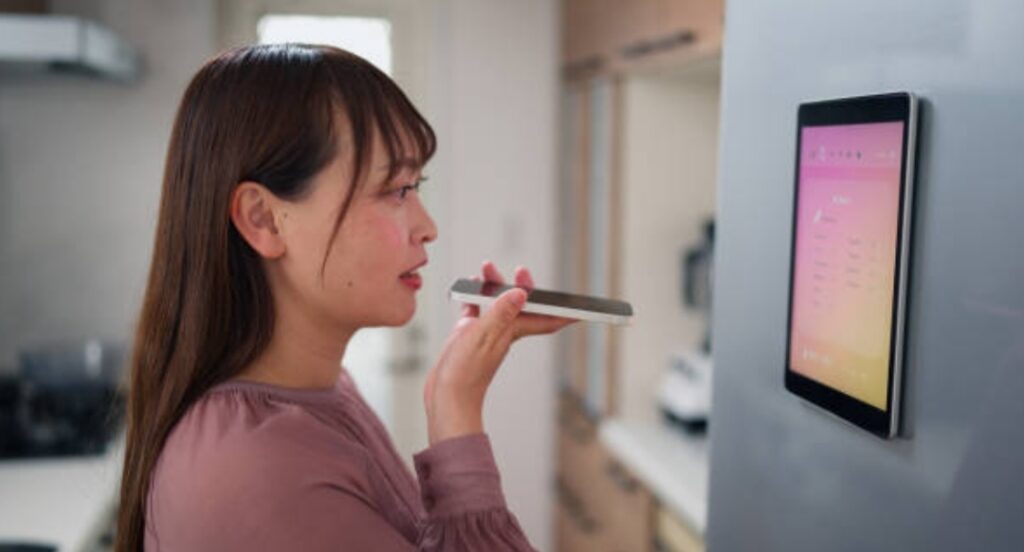
Maximize Food Freshness with Smart Cooling Features
Another key benefit of owning a smart fridge is its ability to maintain the ideal environment for your food.
By using smart cooling features, you can extend the shelf life of your produce, meats, and dairy, reducing food waste and ultimately saving money.
Here’s how you can use your smart fridge to keep your food fresher for longer:
- Activate Smart Compartments (e.g., Prime Freeze, Quick Chill)
Some smart fridges come with specialized compartments designed for specific types of food storage.
For example, Samsung’s Prime Freeze and Quick Chill features optimize temperature and humidity for items that require a particular storage environment.
Prime Freeze ensures that frozen items are stored at the optimal temperature, while Quick Chill rapidly cools beverages or leftovers to the right temperature.
These features ensure that your food stays fresher for longer, reducing spoilage and the need to throw away items.
- Use the App to Monitor Real-Time Humidity and Temperature
Smart fridges often come equipped with sensors that allow you to monitor and adjust the temperature and humidity levels of individual compartments.
For example, you can set the fridge’s vegetable drawer to a higher humidity setting to keep your fruits and veggies fresh longer, or set the meat compartment to a colder setting to prevent premature spoilage.
By using the app to monitor these real-time conditions, you can fine-tune the fridge to match the specific needs of different types of food.
- Optimal Freshness with Airflow Control
Many high-end smart fridges offer advanced airflow control systems that evenly distribute cool air throughout the refrigerator.
This helps maintain a consistent temperature, ensuring that no area of the fridge is too warm or too cold, which can lead to spoilage.
Keeping your fridge well-balanced in terms of airflow helps extend the freshness of your groceries, saving you from having to replace food items prematurely.
When to Contact Support or Schedule Professional Help
Smart fridges are sophisticated appliances with various features that enhance convenience and efficiency.
However, like any advanced technology, they may occasionally experience issues.
Understanding when to contact support or schedule professional help can save you time, money, and frustration.
In this section, we’ll cover key indicators that your smart fridge might need servicing, how to reach the right manufacturer support, and tips for ensuring your warranty and service needs are handled effectively.
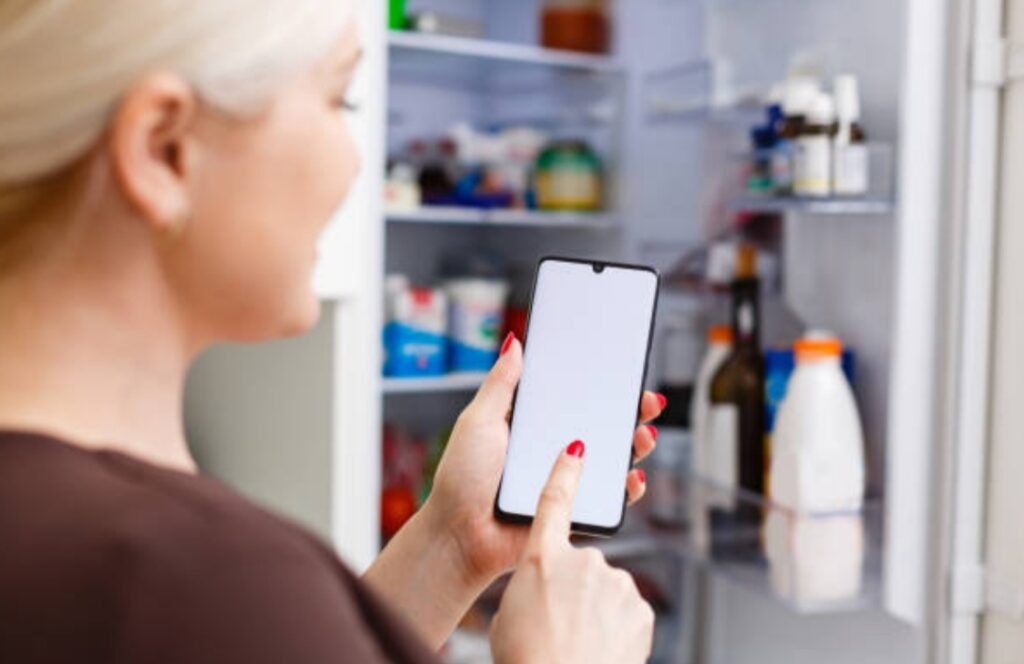
Indicators Your Smart Fridge Needs Servicing
Even though smart fridges are designed to be reliable, there are a few signs that something may be wrong with your appliance.
It’s essential to pay attention to these indicators early to avoid more severe issues later on.
- Persistent Wi-Fi Disconnections
One of the most common problems with smart fridges is connectivity issues.
If your fridge frequently disconnects from Wi-Fi, it could disrupt the functionality of smart features like inventory tracking, remote control, or app notifications.
If restarting the appliance and router doesn’t resolve the issue, there might be an underlying hardware or software problem that requires professional troubleshooting.
- Unresponsive Control Panel
The control panel of your smart fridge serves as the hub for interacting with its various features, from adjusting temperatures to activating smart settings.
If the touchscreen or physical buttons are unresponsive or malfunctioning, it could be due to a software glitch or a hardware issue.
In such cases, it’s best to contact support to resolve the issue or have the panel professionally repaired.
- Unusual Noises or Error Codes
If your smart fridge starts making strange noises or displaying error codes on its control panel, it could indicate a problem with its cooling system, sensors, or another essential component.
Error codes often provide helpful information that can direct service professionals to the root cause of the issue.
If the noises persist, it’s wise to call for technical assistance to avoid further damage.
How to Contact Manufacturer Support
When your smart fridge encounters an issue that requires professional assistance, contacting the manufacturer’s customer support team is usually the first step.
Different brands offer various avenues to reach support, so it’s essential to know where to go for help.
- Samsung SmartThings Support
For Samsung smart fridges, the primary support platform is the Samsung SmartThings app or website.
Samsung provides troubleshooting steps, firmware updates, and the option to contact customer service through their website or app.
You can also find a list of authorized service centers for repairs. For any urgent issues, you can contact their helpline directly for immediate assistance.
- LG ThinQ Help Center
LG offers robust customer support for its ThinQ-enabled smart fridges through its official help center.
You can find FAQs, troubleshoot common issues, and access detailed product manuals.
If you need to speak with a representative, LG provides live chat and phone support, and you can schedule repairs through their portal.
LG also has a dedicated mobile app to manage and troubleshoot your fridge remotely.
- Whirlpool Connected Appliances
Whirlpool smart fridges are supported by their Connected Appliances platform, where you can troubleshoot problems, update software, and contact customer service.
Whirlpool’s customer support also offers online service scheduling and provides detailed instructions for resolving basic problems.
If you need in-person service, they will direct you to local authorized technicians.

Tips for Warranty Registration and Service Scheduling
Properly registering your smart fridge and scheduling professional service can extend the lifespan of your appliance and protect your warranty.
Here are some important tips to ensure everything is covered:
- Register Your Product During Setup
When you first install your smart fridge, be sure to register your product with the manufacturer.
Most brands offer an easy online registration process via their website or mobile app.
Registration typically includes entering your fridge’s model and serial number, as well as your purchase date.
This information is crucial for warranty claims and service requests, as it helps verify your appliance’s eligibility for repairs or replacements.
- Store Your Receipt and Model/Serial Number
Keep a copy of your receipt and note your fridge’s model and serial numbers in a safe place.
This information will be necessary when you contact support for troubleshooting or schedule a service appointment.
The model and serial numbers are typically located inside the fridge, near the door frame or on a label.
Storing this information ensures you can quickly resolve any issues with minimal hassle.
- Schedule Professional Service When Necessary
If you can’t resolve an issue through basic troubleshooting, it’s essential to schedule professional service.
Most manufacturers provide a service request option via their website, mobile app, or support center.
If your fridge is under warranty, they may offer free or discounted repairs. Be sure to follow up on any service appointments and track the progress of your request.
FAQs About How to Set Up a Smart Fridge
When setting up your new smart fridge, it’s common to have questions.
To make sure you’re equipped with the right answers, we’ve compiled a list of frequently asked questions (FAQs) to guide you through the process.

What’s the first step in setting up a smart fridge?
The first step in setting up a smart fridge is to unbox and position it correctly in your kitchen.
Make sure there’s enough clearance around the fridge for proper ventilation.
Once the fridge is in place, level it and connect it to power.
After this, you can move on to connecting it to Wi-Fi and setting up any smart features via the manufacturer’s app.
Can I set up a smart fridge without a smartphone?
While it is technically possible to set up a smart fridge without a smartphone, doing so will limit the use of advanced features like remote control, app-based monitoring, and smart notifications
Most smart fridges require the manufacturer’s mobile app for full functionality, such as connecting to Wi-Fi, managing settings, and using smart features like grocery tracking or energy efficiency settings.
Do I need an app for every feature?
Yes, most smart fridges require an app to access their smart features.
For instance, apps like Samsung SmartThings, LG ThinQ, and others enable you to control settings remotely, monitor food inventory, or receive alerts.
Some fridges may offer basic functions without the app, but for full integration into a smart home ecosystem, using the app is highly recommended.
How do I know if my fridge is connected to Wi-Fi?
To confirm that your fridge is connected to Wi-Fi, open the manufacturer’s app and check the fridge’s status.
Many smart fridges also display a Wi-Fi indicator light on their control panels.
If you’re unsure, go to the fridge’s network settings in the app and verify that it is connected to your home network. If it isn’t connected, you may need to restart the fridge or your router.
What smart features should I enable first?
When setting up your smart fridge, here are the essential features to enable first:
- Wi-Fi connectivity: To access the fridge remotely via the app.
- Energy monitoring: For tracking power consumption and optimizing energy use.
- Inventory tracking: Start with enabling camera features or barcodes for easy food tracking.
- Smart cooling adjustments: Activate settings for temperature management based on usage patterns.
These features are the foundation for optimizing your fridge’s smart capabilities.
Final Thoughts: Getting the Most from Your Smart Refrigerator
Setting up a smart fridge is just the beginning of enjoying a seamless, high-tech kitchen experience.
These innovative appliances are designed to enhance your lifestyle by offering convenience, energy efficiency, and a range of features that support smarter food management.
To ensure that you’re truly getting the most out of your investment, consider the following key points as you continue to explore your fridge’s capabilities.
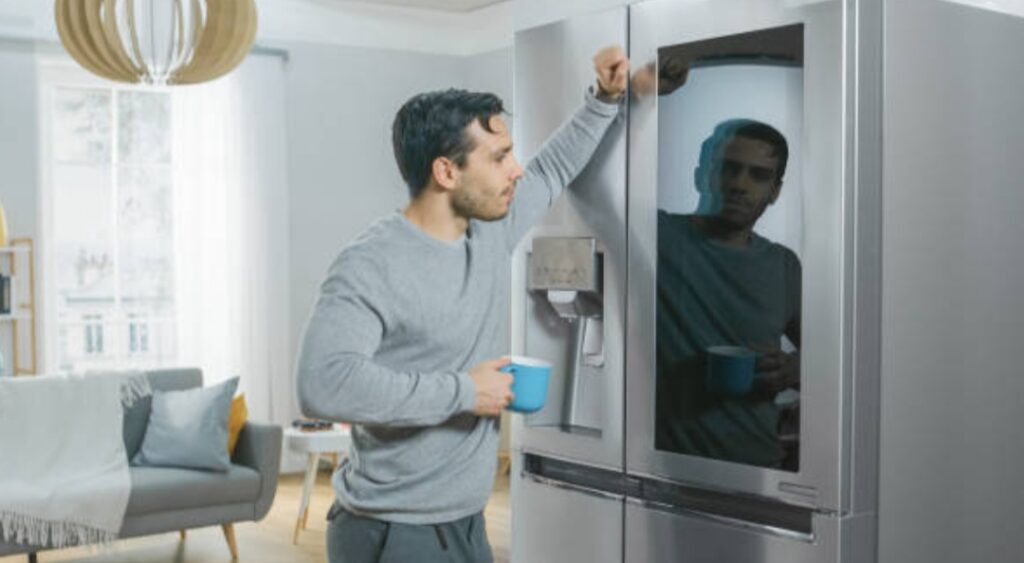
Embrace the Convenience of Automation
One of the primary advantages of owning a smart fridge is the ability to automate tasks that were once time-consuming.
Smart grocery lists, expiration alerts, and even recipe suggestions based on the ingredients you have available can save you a lot of time.
The internal cameras in your fridge allow you to check what’s inside without opening the door, helping you make smarter purchasing decisions and reducing food waste.
By integrating your fridge with compatible smart home devices, you can also manage other aspects of your kitchen environment.
For example, you can adjust your fridge settings remotely or pair it with other smart home systems to control lighting, temperature, and security from your smartphone or voice assistant.
Optimize Energy Usage and Food Freshness
Smart fridges come equipped with energy-saving features that help you reduce your household’s energy consumption.
Using smart scheduling features, you can set your fridge to adjust its cooling based on when you’re home or away.
Additionally, you can activate features like Prime Freeze or Quick Chill to preserve food freshness and extend shelf life.
To further maximize food freshness, take advantage of the fridge’s smart cooling systems.
These features ensure that specific compartments maintain the optimal temperature and humidity levels, which is crucial for preserving everything from fruits and vegetables to dairy products.
Stay Up to Date with Software and Security
Regularly updating the firmware of your fridge ensures that you’re getting the latest performance improvements, security patches, and new features.
Many modern smart fridges allow for automatic updates, but it’s always a good idea to check periodically for any new updates available through the app.
Keeping your fridge’s software up to date not only enhances its functionality but also ensures that you’re using the most secure version available, protecting your data from potential threats.
Enjoy Seamless Integration with Your Smart Home
As you get more accustomed to the features of your smart fridge, consider integrating it into your larger smart home ecosystem.
Pair it with voice assistants like Amazon Alexa or Google Assistant to make hands-free adjustments, such as controlling the temperature, checking your fridge’s contents, or setting reminders for food expiration.
This integration makes your kitchen more efficient and creates a streamlined, connected environment in your home.
Explore the Full Potential of Your Smart Fridge
To truly get the most out of your smart fridge, don’t just use it as a regular appliance.
Explore the app features, experiment with energy-saving modes, and integrate your fridge with other smart devices to unlock its full potential.
The more you engage with the various smart features, the more you’ll appreciate how these appliances revolutionize your daily routines.
Take action today and start using your smart fridge to save time, reduce waste, and enjoy a smarter, more connected kitchen experience.
Get started now with our recommended smart fridge models and accessories to elevate your home appliance game!
You might also like :

